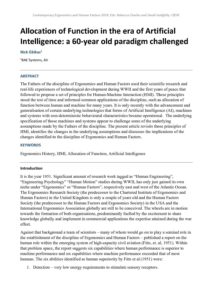| Document | Author Nick Gkikas |
| Abstract The Fathers of the discipline of Ergonomics and Human Factors used their scientific research and real-life experiences of technological development during WWII and the first years of peace that followed to propose a set of principles for Human-Machine Interaction (HMI). These principles stood the test of time and informed common applications of the discipline, such as allocation of function between human and machine for many years. It is only recently with the advancement and generalisation of certain underlying technologies that forms of Artificial Intelligence (AI), machines and systems with non-deterministic behavioural characteristics became operational. The underlying specification of those machines and systems appear to challenge some of the underlying assumptions made by the Fathers of the discipline. The present article revisits those principles of HMI, identifies the changes in the underlying assumptions and discusses the implications of the changes identified to the discipline of Ergonomics and Human Factors. |

